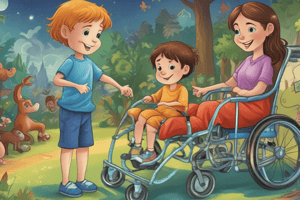Podcast
Questions and Answers
The inability to perceive two points of stimulation is referred to as loss of point discrimination.
The inability to perceive two points of stimulation is referred to as loss of point discrimination.
True (A)
Hypoalgesia refers to the increased sensation of pain.
Hypoalgesia refers to the increased sensation of pain.
False (B)
Dysarthria is characterized by errors in the respiratory, laryngeal, resonance, articulation, and prosodic components of speech.
Dysarthria is characterized by errors in the respiratory, laryngeal, resonance, articulation, and prosodic components of speech.
True (A)
Nonprogressive lesions in CP indicate that individuals will not experience changes in physiological effects due to neural maturation.
Nonprogressive lesions in CP indicate that individuals will not experience changes in physiological effects due to neural maturation.
Astereognosis is the loss of the ability to recognize forms and shapes with eyes closed.
Astereognosis is the loss of the ability to recognize forms and shapes with eyes closed.
Cognitive dysfunctions occur more frequently in dyskinetic forms of cerebral palsy than in spastic forms.
Cognitive dysfunctions occur more frequently in dyskinetic forms of cerebral palsy than in spastic forms.
Intensive therapeutic intervention is less likely to help children with language delays who have multiple associated problems.
Intensive therapeutic intervention is less likely to help children with language delays who have multiple associated problems.
Idiosyncratic influences such as family and environment have no effect on language development.
Idiosyncratic influences such as family and environment have no effect on language development.
Dysarthria in children can be caused by neurological injuries during their developmental period.
Dysarthria in children can be caused by neurological injuries during their developmental period.
The role of a pediatrician in assessing children with cerebral palsy is limited to prescribing medications.
The role of a pediatrician in assessing children with cerebral palsy is limited to prescribing medications.
The Goldman-Fristoe Test of Articulation is used to assess articulation and motor speech.
The Goldman-Fristoe Test of Articulation is used to assess articulation and motor speech.
The point place model assesses errors in speech production using a subjective rating scale.
The point place model assesses errors in speech production using a subjective rating scale.
Dysfunction in neuromuscular control can lead to slowness of movement among children with dysarthria.
Dysfunction in neuromuscular control can lead to slowness of movement among children with dysarthria.
Communication Matrix is a tool used to assess language development in children.
Communication Matrix is a tool used to assess language development in children.
Primitive reflexes are typically absent in children with cerebral palsy.
Primitive reflexes are typically absent in children with cerebral palsy.
Flashcards
Loss of 2-point discrimination
Loss of 2-point discrimination
Inability to feel two points of stimulation simultaneously, suggesting a problem in the parietal lobe of the brain.
Hypoalgesia
Hypoalgesia
Reduced sensation of pain.
Hyperalgesia
Hyperalgesia
Increased sensation of pain.
Analgesia
Analgesia
Signup and view all the flashcards
Agnosia
Agnosia
Signup and view all the flashcards
Astereognosis
Astereognosis
Signup and view all the flashcards
Developmental Dysarthria
Developmental Dysarthria
Signup and view all the flashcards
Dysfunction in neuromuscular control
Dysfunction in neuromuscular control
Signup and view all the flashcards
Dysarthria
Dysarthria
Signup and view all the flashcards
Process/Physiological Model
Process/Physiological Model
Signup and view all the flashcards
Point-Place Model
Point-Place Model
Signup and view all the flashcards
Reduced Prelinguistic Experiences
Reduced Prelinguistic Experiences
Signup and view all the flashcards
Idiosyncratic Influences
Idiosyncratic Influences
Signup and view all the flashcards
Associated Problems
Associated Problems
Signup and view all the flashcards
Physiological Changes with Maturation
Physiological Changes with Maturation
Signup and view all the flashcards
Study Notes
Assessment of CP
- Assessing sensory abilities involves testing point discrimination, pain, temperature, stereognosis, and vibration sense.
- Point discrimination: Two simultaneous stimuli on different parts of the body; inability to perceive the two points signifies loss of two-point discrimination, suggesting a parietal cortical lesion.
- Pain: Sharp stimuli applied to an area to assess pain response; reduced pain sensation is hypoalgesia; increased pain sensation is hyperalgesia; loss of pain sensation is analgesia.
- Temperature: Testing ability to sense hot and cold; loss of ability to recognize limb position (eyes closed) is agnosia.
- Astereognosis: Inability to recognize form, shape, etc. with eyes closed.
- Loss of vibration sense: Tested with a vibrating stimulus (e.g., tuning fork).
Associated Issues with CP
- Visual and auditory difficulties are common.
- Cognitive dysfunction is more prevalent in spastic CP than in dyskinetic CP.
- Seizures are also possible.
- Emotional and behavioral issues like hyperactivity may occur.
- Pseudo-degeneration can occur due to reduced use of structures affected by neuromotor impairment.
- Orthopedic difficulties are present, and perceptual problems like agnosia can affect the patient's ability to recognize objects, shapes, and spatial relationships.
- Difficulty with speech, language, and communication also could present.
Role of Professionals
- General practitioners (GPs) identify early signs, refer to specialists, and provide counseling.
- Paediatricians diagnose and monitor growth and development.
- Neurologists assess neurological status and prescribe medications.
- Neurosurgeons might be involved.
- Orthopaedic surgeons prescribe orthotic aids.
- Speech-language pathologists (SLPs), physical therapists (PTs), and occupational therapists (OTs) are important.
- Special educators help with reading and writing skills.
- Social workers provide support to the patient and family.
Developmental Dysarthria
- Dysarthria is a speech disorder due to neurological injury.
- If the onset occurs during the developmental period, it's termed developmental dysarthria.
Motor Speech Disorders in Children (Dysarthria)
- Dysarthria affects all speech systems or unitary systems.
- Assessment involves perceptual and objective measures (acoustic, aerodynamic, kinematic, muscular).
- Neuromuscular control dysfunction can manifest as weakness, slowness, or lack of coordination, often due to spasticity, flaccidity, or involuntary movements.
Dysarthria: Specific Features
- Speech may be immature, needing repeated assessments to capture changing features with age.
- Reflexes may be primitive or pathologic, especially in CP.
- Specific symptom clusters might exist in syndromic or metabolic conditions.
- Language development delay can result.
- Non-progressive lesions in CP may have evolving physiological effects due to neural maturation.
- Associated problems necessitate intensive therapeutic interventions, potentially delaying language development.
- Reduced prelinguistic experiences and abilities.
- Idiosyncratic factors (family, environment, needs) influence outcomes.
Specific Errors of Speech System
- Respiratory, laryngeal, resonance, articulation, prosodic, and language errors are outlined by speech system, and examples for each. Specific examples of disorders like athetoid, spastic, and ataxic are given with pitch, loudness, quality, prosody, along with examples of abnormal prosody.
SLPs Assessment Models
- Process/physiological model
- Articulation & Motor Speech: Goldman-Fristoe Test of Articulation, Frenchay Dysarthria Assessment
- Language: CELF, PLS (receptive and expressive), REEL
- AAC: Communication Matrix (Dynamic AAC Goals Grid)
- Swallowing: VFSS or FEES
- Respiratory: Manometers, spirometers, measures of lung volumes and capacities.
SLPs Assessment Models (Point Place)
- Speech production quality is evaluated through specific points of assessment, or valves.
- Each system's valves is assessed and categorized as Normal (0) or Severe (6)
- Respiratory system, Phonatory valve, Resonatory valve, and Articulatory valves are the main assessment for detailed evaluation and treatment.
Studying That Suits You
Use AI to generate personalized quizzes and flashcards to suit your learning preferences.




